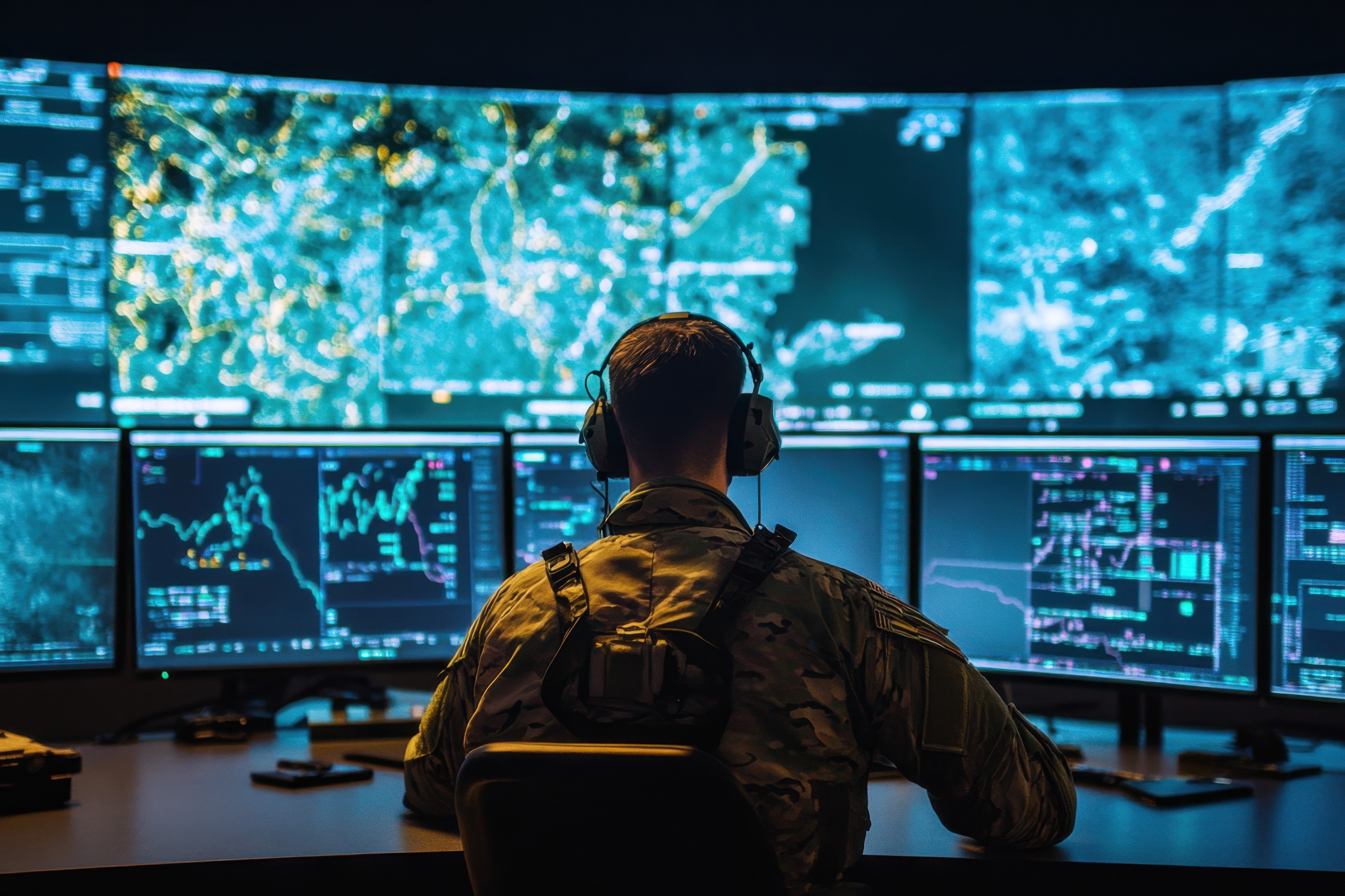Modern military operations unfold across fast-changing, contested environments where adversaries adapt quicker than training cycles can keep up. Traditional methods can’t provide the speed or scale needed for informed decision-making.
Simulation wargaming closes that gap by accelerating cognitive feedback loops, enabling commanders to rehearse dozens of scenarios in the time it once took to plan a single live exercise.
Why simulation wargaming matters for operational thinking
Multi-domain operations demand synchronized decisions across land, sea, air, space, and cyberspace often within minutes. Traditional training methods like quarterly field drills or annual command post exercises can’t provide the repetition density required to build true decision fluency at that tempo.
Simulation wargaming changes that by creating repeatable, controlled environments where command staffs can test decision pipelines under pressure and refine team coordination. Tools like Command: Modern Operations Professional Edition (Command PE) deliver theater-level fidelity with accurate sensor, communication, and weapons models enabling exploration of “what if” scenarios impossible or too costly to attempt live.
The outcome is cognitive acceleration compressing months of operational learning into weeks of high-repetition simulation. With the global simulation market projected to hit $1.4 trillion by 2034 and showing 36% performance gains over traditional methods, teams that integrate simulation wargaming gain a decisive adaptation advantage over those limited to live exercises.
Defining simulation wargaming and its role in training
Table-top vs digital simulation vs LVC
Tabletop wargames use maps and facilitator-adjudicated rules. Strengths: low cost, rapid setup, excellent for doctrinal debate. Limitations: subjective adjudication, limited scale, no quantitative data.
Digital simulation wargames (Command PE, JSAF) execute physics-based models. Strengths: objective resolution, theater-level scale, automated after-action data. Limitations: requires technical expertise, higher initial cost.
Live-Virtual-Constructive (LVC) blends real operators in simulators with computer-generated forces. Strengths: combines human-in-the-loop realism with simulation scale. Limitations: complex integration, latency-sensitive, expensive infrastructure.
Best practice: Use tabletop for concept exploration, digital simulation for repeatable training with metrics, LVC for mission rehearsal with actual crews.
The training cycle and key benefits
Effective wargaming follows: scenario design (training objectives → simulation setup) → execution (trainees make decisions, respond to events) → after-action review (quantitative metrics + qualitative discussion).
Key benefits:
- Repeatability: Run identical scenarios to measure learning progression—impossible with live exercises where conditions constantly change
- Controlled variation: Systematically vary factors to isolate cause-and-effect
- Safe failure: Explore aggressive tactics without actual losses
- Fast feedback: Immediate quantitative data accelerates learning vs. delayed live-exercise AARs
Studies show simulation training produces 230% improvement in knowledge retention compared to traditional methods.
Core components of high-fidelity wargaming systems
Simulation engine and fidelity trade-offs
Engines compute physical interactions: radar detection based on RCS and atmospheric conditions, missile kinematics with countermeasures, communication availability accounting for jamming and terrain masking.
Fidelity levels:
- Low: Abstract models (all jets fly 400 kts, fixed hit probabilities). Use for concept exploration.
- Medium: Physics-based movement, sensor detection models, detailed weapons effects. Command PE operates here—theater accuracy without excessive setup time.
- High: Engineering-level models (radar waveforms, 6-DOF dynamics). Use for tactics development and systems testing.
Balance simulation fidelity against training objectives. Over-fidelity wastes time; under-fidelity produces misleading lessons.
Scenario libraries and dynamic environments
Pre-built templates (Black Sea interdiction, South China Sea operations) accelerate development. Dynamic event injection prevents predictability adversary adapts based on Blue's actions, forcing adaptive thinking versus rote memorization.
Scenario maintenance is critical: new adversary capabilities, updated doctrine, geographic contingency shifts require regular updates. Without maintenance, scenarios become obsolete within 12-18 months.
After-Action Review analytics
Transform raw simulation logs into actionable feedback:
- Decision timelines: When did decisions occur relative to information availability?
- Force employment: Were units engaged effectively or idle?
- Communication analysis: Information flow bottlenecks and gaps
- Outcome variation: High variance suggests scenario rewards good decisions; low variance suggests deterministic outcome requiring redesign
How wargaming improves operational thinking
Building cognitive agility under uncertainty
Wargaming forces decisions before perfect information arrives. Trainees must act on fragmentary intelligence, commit strike assets with imperfect targeting data, or wait and risk adversary surprise. After 20 iterations, trainees internalize information-action trade-offs.
Result: Simulation-trained decision-makers exhibit 14-36% faster decision loops and higher decision quality under stress compared to classroom-only training.
Testing COAs and decision pipelines
Traditional planning generates 2-3 COAs evaluated subjectively in tabletop sessions. Simulation-based analysis: generate 5-10 variants, execute each 10+ times with different conditions, aggregate statistical outcomes.
Result: Evidence-based COA selection. "COA A succeeds 78% with 4 aircraft lost; COA B succeeds 85% but loses 7 aircraft; COA C succeeds 62% but loses 2. Commander decides: accept higher risk for higher success, or prioritize force preservation?"
Team coordination and shared situational awareness
Repeated coordination challenges build habitual synchronization. First iteration: late SEAD, strike aircraft take losses. AAR identifies gaps. By the tenth iteration, coordination becomes proactive—teams anticipate needs without explicit requests.
Analytics quantify: coordination latency decreased 40% from iteration 1 to 10, decision synchronization improved 48%.
Experimentation and doctrine testing
Wargaming serves a dual purpose: training and experimentation. Test new tactics, systems, doctrine before real-world implementation.
Examples:
- Compare dispersed vs. concentrated basing under missile threat
- Evaluate Advanced Battle Management System impact on kill chain speed
- Validate new joint fires doctrine coordination procedures
Statistical rigor: Run 100+ iterations per configuration, compare distributions. Report mean and variance—new tactics may improve average 10% but increase worst-case failures 30%.
War-fighter feedback: Operators participate in simulation using proposed capabilities, discovering employment limitations specs don't capture: "New ISR has great sensors but insufficient loiter time—we'd need 3× as many for persistent coverage."
Implementation challenges
Cost and maintenance
Commercial platforms (Command PE Professional) run $5,000–$20,000 per license. High-fidelity DoD simulations require six-figure licenses plus infrastructure. The total cost for large programs reaches millions.
Mitigation: Amortize across a large user base, use modular scenario design, implement automated validation detecting when real-world changes invalidate scenarios.
Validity and behavioral fidelity
Scenarios must represent operational reality closely enough for training to transfer. Threats: out-of-date adversary models, optimistic assumptions (reliable communications, no friction), geographic mismatches.
Mitigation: Validate against real-world data, refresh scenarios annually minimum, inject friction deliberately. For behavioral fidelity, establish training rules emphasizing operational judgment, run at realistic tempo, use external evaluators.
Avoiding "exercise-only" traps
Risk: proficiency in simulation that doesn't transfer to operations. Causes: scenario-specific optimization (memorizing solutions), simulation artifacts (interface shortcuts not present in real systems), missing integration with actual C2 systems.
Mitigation: LVC integration, extensive scenario variation, periodic live exercises validating transfer. Compare simulation-trained vs. traditionally-trained units in live exercises—gold standard is 40%+ performance advantage.
How BQP supports simulation wargaming at scale
BQP accelerates simulation wargaming by automating scenario generation, optimization, and analysis with quantum-inspired algorithms and physics-informed models. It reduces manual setup time while ensuring realism through adaptive adversary behavior and accurate sensor-weapon dynamics.
Integrated analytics and LVC connectivity transform raw simulation data into actionable insights, enabling faster iteration, measurable learning gains, and seamless integration into existing defense training ecosystems.
Quantum-inspired scenario generation: Traditional development is labor-intensive. BQP's QIEO solvers and Physics-Informed Neural Networks automate generation—specify training objectives and parameter ranges, BQP creates optimized variants 20× faster. Hybrid AI-physics models ensure realistic sensor/weapons models with adaptive adversary AI.
Scenario optimization: BQP analyzes parameter space identifying configurations that challenge appropriately (~70% success rate with good decisions). For branching wargames, optimization generates balanced decision trees.
Analytics dashboards: Transform millions of data points into actionable feedback—decision-quality scoring, coordination metrics, learning progression tracking. Visualize trends guiding instructor interventions.
LVC connectivity: Integrates with existing infrastructure (HLA/DIS federation, C2 system APIs, LMS standards). Layer BQP onto current platforms gaining quantum-inspired performance while preserving workflows.
Pilot programs: 6-12 week engagements validating specific use cases, demonstrating measurable improvements before full commitment.
Experience next-generation wargaming performance — book a demo to see how BQP transforms simulation training from static exercises into adaptive, data-driven operations.
Best practices & implementation checklist
Define objectives and metrics upfront: Specific goals ("reduce kill chain latency 45min → <20min") enable targeted design and assessment. Metrics must be observable, relevant, achievable, and validated against operational performance.
Align scenarios with mission tasks: Build based on operational mission essential tasks, not technical ease. Include core templates, variants testing specific skills, and progressive difficulty levels.
Enable data-driven AARs: Log everything, instrument performance metrics, automate processing. Review quantitative metrics first, then qualitative discussion, finish with action items.
Validate and update models: Annual validation minimum comparing simulation outcomes against operational data. Red team scenarios with adversary SMEs ensuring realistic behavior.
Integrate feedback loops: Collect trainee, instructor, and quantitative feedback after each cycle. Quarterly reviews identify patterns informing scenario refinement.
Conclusion
Simulation wargaming compresses experiential learning into iterative cycles exceeding what field exercises alone provide. The global market's growth to $1.4 trillion by 2034 reflects demonstrated value: 36% performance improvements, 230% retention gains, 20% cost reductions.
Organizations that excel architect integrated ecosystems combining physics-fidelity models, adaptive AI, data-driven analytics, and continuous operational validation. They iterate with current tools rather than waiting for perfect technology.
BQP accelerates this transformation: quantum-inspired optimization 20× faster, physics-informed networks ensuring operational fidelity, analytics quantifying learning outcomes. Whether enhancing Command PE programs, evaluating doctrine, or preparing for operations, the question isn't whether simulation should be part of your strategy—it's whether you're exploiting its full potential.
FAQs
How often should scenarios be changed?
For recurring training, change every 3-6 months to prevent memorization. For one-time training (pre-deployment), use 8-10 variants over 2-4 weeks with tactical variation while preserving operational context. For experimentation, keep scenarios stable to enable controlled comparison. Monitor metrics: if learning plateaus, introduce variation or shift scenarios.
Can simulation replace live training?
No. Simulation excels at cognitive skill development through high-repetition practice. But it can't replicate physical stress, psychological pressure of real consequences, equipment quirks from hands-on use, or organizational friction affecting execution. Optimal blend: simulation for cognitive training, live exercises for validation and discovering integration issues.
How do you measure wargame effectiveness?
Multi-level assessment: (1) Immediate learning: improved performance within cycle (decision speed, quality, coordination, error rates). (2) Retention: re-test 30-90 days post-training. (3) Transfer: compare simulation-trained vs. traditionally-trained units in live exercises—gold standard is 40%+ advantage. (4) Operational impact: surveys of operators assessing whether training prepared them for actual challenges.





.png)
.png)




.svg)
.svg)
.svg)
.svg)